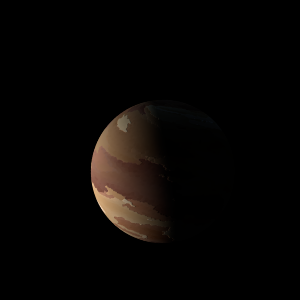|
|
Space Astro
|
Info for exoplanet "Nyongk'ye"
| Scientific (actual) data |
|---|
| Name | Kepler-235 e |
| Planet status | Confirmed |
| Radius | 0.198 |
| Orbital period | 46.1837 |
| Semi major axis | 0.213 |
| Discovered | 2014 |
| Updated | 2021-02-05 |
| Tconj | 2455000 |
| Impact parameter | 0.68 |
| Publication | Announced on a website |
| Detection type | Primary Transit |
| Alternate names | 2MASS J19041898+3916419 e, K00812.03, KIC 4139816 e, KOI-812 e, KOI-812.03, WISE J190418.97+391641.8 e |
| Star name | Kepler-235 |
| Right ascension | 286.08° |
| Declination | 39.28° |
| Mag j | 13.952 |
| Mag h | 13.278 |
| Mag k | 13.116 |
| Star distance | 433.24 |
| Star metallicity | 0.087 |
| Star mass | 0.59 |
| Star radius | 0.55 |
| Star sp type | M0 V |
| Star temperature | 4255 |
| Star alternate names | 2MASS J19041898+3916419, KIC 4139816, KOI-812, WISE J190418.97+391641.8 |
| Wikipedia article | Kepler-235 e |
Back
| |
| Fictional info (?) |
|---|
| Suggested name | Nyongk'ye |
| Planet type | Cold planet |
| .
The volume of water ice in the south polar ice cap, if melted, would be sufficient to cover the entire planetary surface to a depth of 8 meters. The volume of water detected has been estimated to be equivalent to the volume of water in Lake Superior. |
| Atmosphere | Molecular hydrogen | 75% |
| Ammonia | 25% |
| Water vapor | 0.23% |
| 2H2O | 0.0091% |
| Methane | 0.0025% |
| Atmospheric pressure | 4 bar |
 |
| No known satellites |
| Google search for Nyongk'ye |
|
Website by Joachim Michaelis
|
|
|
|